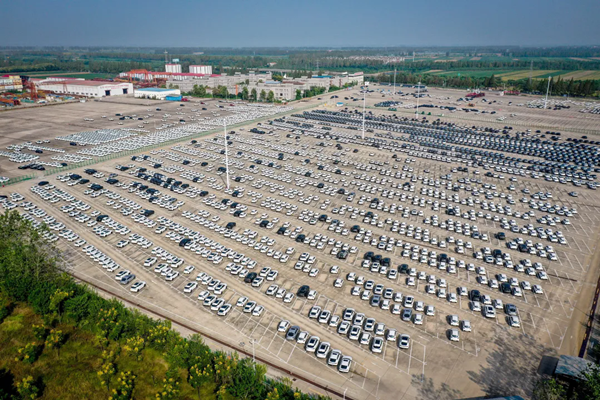

Cars are unloaded into a parking area of the Hannan Port and await transshipment. [Photo/WeChat account: whkfq]
Hannan Port, a national first-class port, has recently been approved for temporary opening, marking a significant milestone in making car exports from Wuhan more convenient and efficient.
The port is the only foreign trade container port in the upper reaches of the Yangtze River within Wuhan and the city's second foreign trade container port, as well as one of the few ports in the middle and upper reaches of the Yangtze River capable of handling roll-on/roll-off (Ro-Ro) vessels for car exports.
The port is also the largest Ro-Ro port in the region, with an annual car handling capacity of 300,000 vehicles. The comprehensive terminal at WEDZ Port spans a 330-meter shoreline, featuring three berths with a designed annual cargo throughput capacity of 2.3 million metric tons and a container handling capacity of 400,000 TEUs (twenty-foot equivalent units).
"The temporary opening approval allows export vehicles, which previously had to be transported to coastal ports via domestic trade channels before being shipped abroad, to be directly transported overseas through Hannan Port," explained Du Haikun, director of WEDZ Comprehensive Bonded Zone and Port Logistics Park.
Du added that prior to this approval, exporting cars required transportation to coastal ports, involving complicated and time-consuming customs and tax refund procedures. Vehicles often had to wait at least two months for shipping schedules or available slots, further extending the export cycle.
Du revealed plans to commence car exports in March, with a batch of WEDZ-made vehicles set to undergo local customs declaration and clearance. The entire process, from local customs declaration to inspection and clearance, will take no more than two working days, allowing for local customs declaration, same-day inspection, same-day clearance, and next-day shipment.
This new process will reduce the cost of exporting each vehicle by at least 1,000 yuan ($137.32) compared to the traditional container river-sea intermodal transport model.
Du noted that the port plans to develop near-sea routes to Japan and South Korea, as well as direct routes to Shanghai and Taicang. It will also accelerate the creation of an open platform that connects rivers and seas, boosting the speed of car exports from Wuhan.